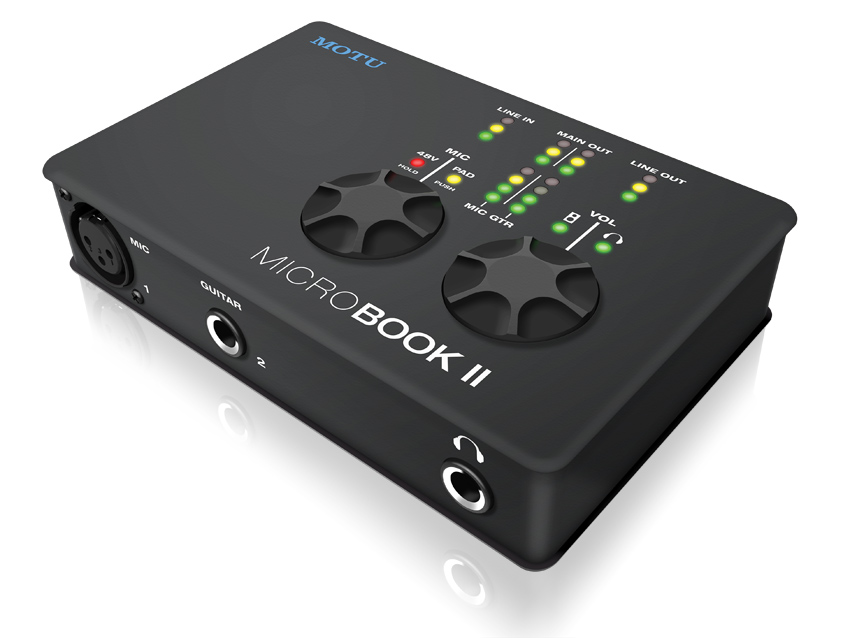MOTU MicroBook II: portable audio interface updated

MOTU has unveiled the MicroBook II, an update to its compact, portable audio interface.
Whereas the original MicroBook was a 4-in/2-out device, this one is 4-in/6-out. It's also been totally redesigned, and now features a hands-on volume control, USB 2.0 connectivity, an XLR input and 96kHz recording and playback.
Read on to find out more. MicroBook II will ship in the Spring priced at $269, the same as the original version.
MOTU MicroBook II press release
Thursday, January 26, 2012. In a post-NAMM announcement, MOTU unveiled the MicroBook II, an updated version of the compact, studio-grade audio interface that turns a Mac or PC into a personal 4 x 6 recording studio with professional I/O and monitor mixing. The MicroBook II will replace the original model at the same price.
"For discriminating users who insist on the very best audio quality, MicroBook II delivers unmatched performance for compact, personal recording," said MOTU Marketing Director Jim Cooper. "Plug in a mic, guitar, keyboard, and powered speakers, then enjoy sound quality that rivals other audio interfaces in the six to eight hundred dollar range."
The MicroBook II comes in a compact, rugged cast metal case suitable for on-the-go recording, personal studio tracking, laptop-based DJ-ing, and many other recording and playback activities. At only 5.5 x 3.5 x 1.25 inches, the bus-powered MicroBook II has all the great features of the original model, plus hands-on volume control, USB 2.0 connectivity for low-latency performance, more simultaneous outputs (six), an XLR mic input, and support for 96 kHz recording and playback.
I/O engineered for sound quality
Get the MusicRadar Newsletter
Want all the hottest music and gear news, reviews, deals, features and more, direct to your inbox? Sign up here.
The four inputs (mic, hi-Z guitar, and stereo balanced line in) can be recorded simultaneously. The mic preamp delivers neutral coloration and pristine sound, with 20 dB pad and 48V phantom power for condenser mics.
Engineered for exceptional audio quality, the MicroBook II includes balanced analog connectors and digitally controlled analog trim. Input trim is controlled separately from input mix volume, so that users never have to sacrifice sound quality for a balanced mix.
The MicroBook II provides six channels of computer output on eight physical outputs (four pairs): balanced TRS quarter-inch main outs, stereo "mini" line out, S/PDIF digital out, and phones (on a stereo quarter-inch jack). The S/PDIF digital output always mirrors the main outs.
Advanced features
Internal CueMix™ mixing and routing features let users program a different stereo mix for each output pair, consisting of any combination of live inputs and host audio tracks. Alternately, users can send the same mix to multiple outputs, or choose a separate output for the MicroBook's built-in test tone generator or white and pink noise generator.
The driver provides an extra input and output pair for routing complete mixes back to the computer host, for scoping audio streams with the analysis tools in the included CueMix FX software, and for routing virtual instrument (or other host) output to the MicroBook II mixer.
On-board effects include modeled analog EQ and compression, which can be applied with near-zero latency (in the hardware) to live inputs.
MicroBook feature highlights
- - 4-input, 6-output bus-powered "plug-and-play" USB 2.0 audio interface for Mac and Windows.
- - 6 x 8 physical input/output channels.
- - 8-bus digital mixer to route and mix live inputs with computer tracks.
- - Pre-amp equipped mic input with Precision Digital Trim™ 48V phantom power, and 20 dB pad.
- - Hi-Z guitar input with Precision Digital Trim.
- - Stereo line level analog input (balanced TRS quarter-inch or stereo mini).
- - Stereo balanced TRS quarter-inch line level main outs.
- - Stereo eighth-inch "mini" line level out.
- - S/PDIF digital out (duplicates main out).
- - Headphones output on quarter-inch stereo jack with independent volume control.
- - Digitally controlled analog trim for all analog inputs.
- - Digital trim for all outputs.
- - Output volume digital rotary encoder. Push to cycle among three modes: main out, phones, or both.
- - Mic input digital rotary encoder for adjusting trim level, 48V and pad.
- - Dedicated 3- or 4-segment LED meters for all inputs and outputs.
- - CueMix™ FX no-latency mixing and monitoring with EQ and dynamics processing.
- - 7-band parametric EQ and compression.
- - Test tone and white/pink noise generator.
- - Support for recording and playback at 2x sample rates (88.2 and 96 kHz).
- - Advanced audio analysis software tools, including FFT display, spectrogram "waterfall" display, oscilloscope, X-Y plot, and phase torch.
- - Industry standard Mac and Windows audio drivers (Core Audio, Wave, and ASIO) for across-the-board compatibility.
- - Compatible with all current and recent generation Macs and PCs.
- - Includes AudioDesk DAW software, USB cable, and mic cable adapter.
Availability
The MicroBook will ship in the spring of 2012. Price is $269 USD.

I’m the Deputy Editor of MusicRadar, having worked on the site since its launch in 2007. I previously spent eight years working on our sister magazine, Computer Music. I’ve been playing the piano, gigging in bands and failing to finish tracks at home for more than 30 years, 24 of which I’ve also spent writing about music and the ever-changing technology used to make it.









